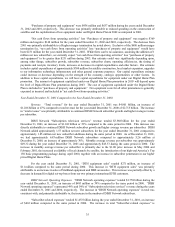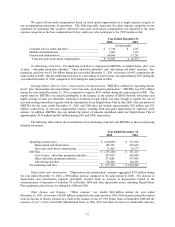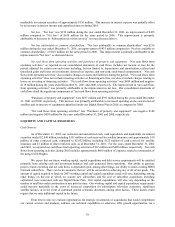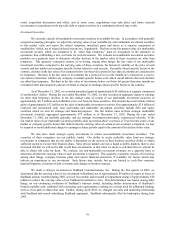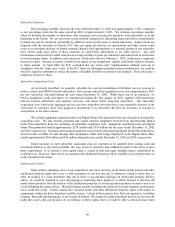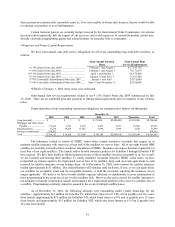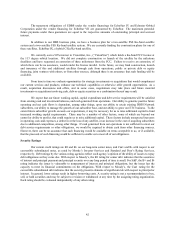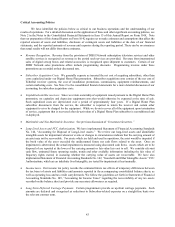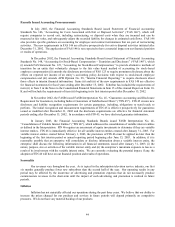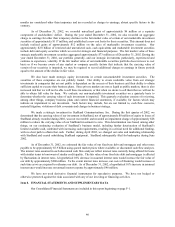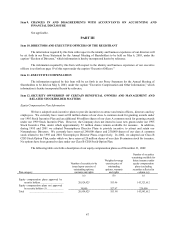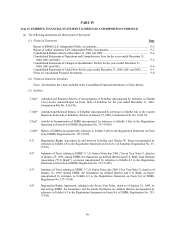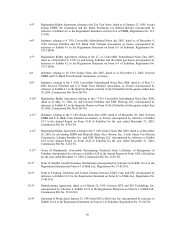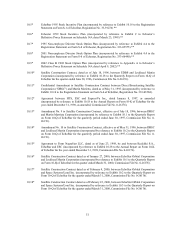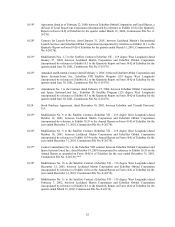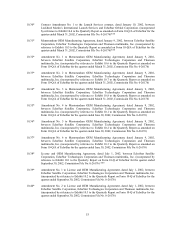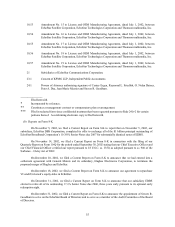Dish Network 2002 Annual Report Download - page 47
Download and view the complete annual report
Please find page 47 of the 2002 Dish Network annual report below. You can navigate through the pages in the report by either clicking on the pages listed below, or by using the keyword search tool below to find specific information within the annual report.45
Item 7A. QUANTITATIVE AND QUALITATIVE DISCLOSURES ABOUT MARKET RISK
Market Risks Associated With Financial Instruments
As of December 31, 2002, our restricted and unrestricted cash, cash equivalents and marketable investment
securities had a fair value of approximately $2.8 billion. Of that amount, a total of approximately $2.7 billion was
invested in: (a) cash; (b) debt instruments of the U.S. Government and its agencies; (c) commercial paper and notes
with an overall average maturity of less than one year and rated in one of the four highest rating categories by at least
two nationally recognized statistical rating organizations; and (d) instruments with similar risk characteristics to the
commercial paper described above. The primary purpose of these investing activities has been to preserve principal
until the cash is required to fund operations. Consequently, the size of this portfolio fluctuates significantly as cash is
received and used in our business.
The value of certain of the investments in this portfolio can be impacted by, among other things, the risk of
adverse changes in securities and economic markets generally, as well as the risks related to the performance of the
companies whose commercial paper and other instruments we hold. However, the high quality of these investments (as
assessed by independent rating agencies), reduces these risks. The value of these investments can also be impacted by
interest rate fluctuations. At December 31, 2002, all of our investments in this category were in fixed or variable rate
instruments or money market type accounts. While an increase in interest rates would ordinarily adversely impact the
fair value of fixed and variable rate investments, we normally hold these investments to maturity. Consequently,
neither interest rate fluctuations nor other market risks typically result in significant gains or losses to this portfolio. A
decrease in interest rates has the effect of reducing our future annual interest income from this portfolio, since funds
would be re-invested at lower rates as the instruments mature. Over time, any net percentage decrease in interest rates
could be reflected in a corresponding net percentage decrease in our interest income. As of December 31, 2002 our
marketable securities portfolio balance was approximately $2.8 billion with an average annual return for the year ended
December 31, 2002 of approximately 2.6%. A hypothetical 10% decrease in interest rates would result in a decrease of
approximately $7 million in annual interest income.
We also invest in debt and equity of public and private companies for strategic and financial purposes. As of
December 31, 2002, we held strategic and financial debt and equity investments of public companies with a fair value
of approximately $73 million. We may make additional strategic and financial investments in other debt and equity
securities in the future.
The fair value of our strategic debt investments can be impacted by interest rate fluctuations. Absent the
effect of other factors, a hypothetical 10% increase in LIBOR would result in a decrease in the fair value of our
investments in these debt instruments of approximately $4.9 million. The fair value of our strategic and financial
debt and equity investments can also be significantly impacted by the risk of adverse changes in securities markets
generally, as well as risks related to the performance of the companies whose securities we have invested in, risks
associated with specific industries, and other factors. These investments are subject to significant fluctuations in fair
market value due to the volatility of the securities markets and of the underlying businesses. A hypothetical 10%
adverse change in the price of our public strategic debt and equity investments would result in approximately a $7.3
million decrease in the fair value of that portfolio.
In accordance with generally accepted accounting principles, we adjust the carrying value of our available-for-
sale marketable investment securities to fair market value and report the related temporary unrealized gains and losses
as a separate component of stockholders’ deficit, net of related deferred income tax, if applicable. Declines in the fair
market value of a marketable investment security which are estimated to be “other than temporary” must be recognized
in the statement of operations, thus establishing a new cost basis for such investment. We evaluate our marketable
investment securities portfolio on a quarterly basis to determine whether declines in the market value of these securities
are other than temporary. This quarterly evaluation consists of reviewing, among other things, the fair value of our
marketable investment securities compared to the carrying value of these securities, the historical volatility of the price
of each security and any market and company specific factors related to each security. Generally, absent specific
factors to the contrary, declines in the fair value of investments below cost basis for a period of less than six months are
considered to be temporary. Declines in the fair value of investments for a period of six to nine months are evaluated
on a case by case basis to determine whether any company or market-specific factors exist which would indicate that
such declines are other than temporary. Declines in the fair value of investments below cost basis for greater than nine


